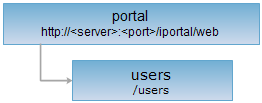<portal_uri>/users[.<format>]
User list. It supports registering new users.
Supported Methods:
Supported output formats: RJSON, JSON, HTML, XML.

Implement the HTTP request on the following URI, where supermapiportal is the server name, with rjson being the output format.
http://supermapiportal:8090/iportal/web/users.rjson
Register new user.
Following arguments need to be passed in the request sent.
| Name | Type | Description |
| name | String | [Required] Password. |
| nickname | String | [Opational] Nickname. If nickname is null, the system will set the account name as the nickname. |
| password | String | [Required] Password. |
| departmentId | Integer | [Opational] Department id. |
| String | [Opational] Email address. |
|
| passwordQuestion | IportalPasswordQuestion | [Opational] It is used to reset password for the security questions and answers |
The structure of the response resource representation is as follows:
| Field | Type | Description |
| succeed | boolean | Whether a new user is registered successfully. |
| error | Httperror | Error information. This field will not be displayed if a new user is registered successfully. |
Execute POST request for users resource http://localhost:8090/iportal/web/users.rjson. The request body is as follows:
{
"name": "user6",
"nickname": "user6",
"password": "iserver`12",
"departmentId": "3",
"email": "user6@rdc.supermap.com",
"passwordQuestion": {
"pwdQuestion": "school",
"pwdAnswer": "仓中"
}
}
The response result in rjson format returned is as follows:
{"succeed": true}
Asks for the response identical to the one that would correspond to a GET request, but without the response body. This is useful for retrieving meta-information written in response headers, without having to transport the entire content. The meta-information includes the media-type, content-encoding, transfer-encoding, content-length, etc.
HEAD request can be used to check if the users resource exists, or if the users resource can be accessed by clients. It can also determine if the users resource supports an output format <format> if performed on a URI with .<format> included.